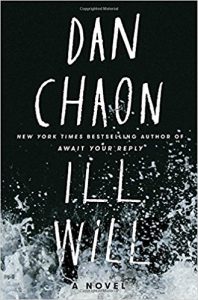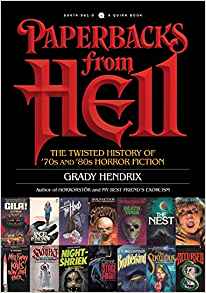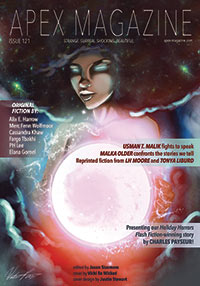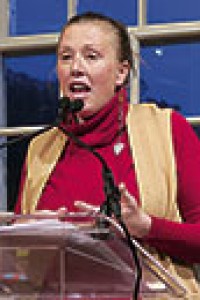2017: A Year Inside the Tent by John Langan
I’ve always subscribed to the big-tent view of horror fiction. While I don’t go so far as to say that horror isn’t a genre (it is), the edges of the field can be difficult to map, especially if your view of it is rooted in its concern with (to paraphrase Stephen King) a pervasive sense of disestablishment, a feeling that things are in the unmaking. 2017 provided a fine example of how capacious the genre can be, with a host of excellent books from writers familiar and fresh.
 Probably the novel of the year is Dan Chaon’s Ill Will, a masterful exploration of memory and the compulsion towards and perils of grand narratives. It’s a big book, literally and figuratively, the kind of novel that invites an immediate re-read. Chaon’s book, however, stretches a neck ahead of a crowded field in a photo-finish, any of whose number might contest the position with vigor. S.P. Miskowski’s I Wish I Was Like You is a posthumous narrative whose first-person narrator’s acerbic voice is a blistering joy. A slender book, it’s an icepick pressed slowly but irresistibly through the heart. Victor LaValle’s The Changeling combines a portrait of a marriage gone horribly wrong in the wake of the couple’s first child, with elements of Scandinavian folklore. It’s a fairy tale of New York that is terrifying and exhilarating. Steve Rasnic Tem’s UBO is unlike any of the other novels in this group, a nightmarish fantasy in which the protagonist is abducted from his bed by monstrous insects and brought to a world where he is forced to inhabit the consciousnesses of history’s great villains. An exploration of the problem of (human) evil, Tem’s narrative cuts to the bone with the brute efficiency of a meat cleaver; it’s a reminder of his continuing ambition as a writer, decades into a career whose achievement is already considerable. The same thing might be said of Peter Straub’s The Process (is a Process All Its Own), a narrative that takes in and juxtaposes Tillman Hayward, the serial killer uncle who features in The Skylark/A Dark Matter and A Secret Place, with Henry James. A mediation on repetition, on what might be called the secret cycles of the world, it powers from gripping scene to gripping scene, concluding with a devastating anecdote that presents an image of despair utter and horrible. Emil Ferris’s My Favorite Thing Is Monsters is a breathtaking blend of word and image, a mystery in which vividly rendered horror tropes realize the perspective of the narrator, a young girl whose attempts to solve a possible crime lead her to the darker avenues of the human experience. Stephen Graham Jones’s Mapping the Interior is another of his high-wire performances, a story of a particularly visceral haunting whose few characters and restricted setting suggest a minimalist drama, and which packs all the punch of a book five times its length. Kristi DeMeester, Michael Griffin, and Laura Mauro all produced compelling debuts (in Beneath, Hieroglyphs of Blood & Bone, and Naming the Bones, respectively).
Probably the novel of the year is Dan Chaon’s Ill Will, a masterful exploration of memory and the compulsion towards and perils of grand narratives. It’s a big book, literally and figuratively, the kind of novel that invites an immediate re-read. Chaon’s book, however, stretches a neck ahead of a crowded field in a photo-finish, any of whose number might contest the position with vigor. S.P. Miskowski’s I Wish I Was Like You is a posthumous narrative whose first-person narrator’s acerbic voice is a blistering joy. A slender book, it’s an icepick pressed slowly but irresistibly through the heart. Victor LaValle’s The Changeling combines a portrait of a marriage gone horribly wrong in the wake of the couple’s first child, with elements of Scandinavian folklore. It’s a fairy tale of New York that is terrifying and exhilarating. Steve Rasnic Tem’s UBO is unlike any of the other novels in this group, a nightmarish fantasy in which the protagonist is abducted from his bed by monstrous insects and brought to a world where he is forced to inhabit the consciousnesses of history’s great villains. An exploration of the problem of (human) evil, Tem’s narrative cuts to the bone with the brute efficiency of a meat cleaver; it’s a reminder of his continuing ambition as a writer, decades into a career whose achievement is already considerable. The same thing might be said of Peter Straub’s The Process (is a Process All Its Own), a narrative that takes in and juxtaposes Tillman Hayward, the serial killer uncle who features in The Skylark/A Dark Matter and A Secret Place, with Henry James. A mediation on repetition, on what might be called the secret cycles of the world, it powers from gripping scene to gripping scene, concluding with a devastating anecdote that presents an image of despair utter and horrible. Emil Ferris’s My Favorite Thing Is Monsters is a breathtaking blend of word and image, a mystery in which vividly rendered horror tropes realize the perspective of the narrator, a young girl whose attempts to solve a possible crime lead her to the darker avenues of the human experience. Stephen Graham Jones’s Mapping the Interior is another of his high-wire performances, a story of a particularly visceral haunting whose few characters and restricted setting suggest a minimalist drama, and which packs all the punch of a book five times its length. Kristi DeMeester, Michael Griffin, and Laura Mauro all produced compelling debuts (in Beneath, Hieroglyphs of Blood & Bone, and Naming the Bones, respectively).
The year also saw a number of outstanding collections. Of these, Mariana Enriquez’s Things We Lost in the Fire was about the strongest, a brilliant blend of tropes taken from the horror tradition with the recent history of Buenos Aires and Argentina. It’s the first of Enriquez’s collections to be translated into English, and it leaves you eager for more. Once again, though, Enriquez’s book has a good deal of competition. In some ways, 2017 might be S.P. Miskowski’s year, because the collection she released towards the end of the year, Strange Is the Night, is every bit the equal of the novel she brought out earlier. Add to these books her Skillute cycle of novels and her previous collection, Red Poppies: 7 Tales of Envy & Revenge, and it’s apparent she’s already established a significant body of work. Jeffrey Thomas released two collections, one at the beginning of the year, The Endless Fall and Other Weird Fictions, and one at the end, Haunted Worlds, and together they demonstrate the range of his interests and the extent of his talent. For some years, now, Thomas has been writing fiction of a singular vision, and these books are a timely reminder of just how good he is. Adam Nevill, who has been steadily producing a series of novels, each of which takes a different approach to constructing a horror narrative, followed up his debut collection, Some Will Not Sleep, with Hasty for the Dark, whose contents further display his engagement with the varied traditions of the field. A quartet of strong first collections round out the category: Nadia Bulkin’s She Said Destroy, Kristi DeMeester’s Everything That’s Underneath: A Collection of Weird and Horror Tales (her second book this year, as well), Philip Fracassi’s Behold the Void, and Gwendolyn Kiste’s And Her Smile Will Untether the Universe. In the diversity of their approaches to the material of horror, as well as the excellence of their writing, they show us that the future of the field has already arrived, and it is thrilling.
 The same variety was on display in the year’s anthologies. While 2017 continued the last several years’ trend of Lovecraft-theme anthologies, it also saw a refreshing number of anthologies devoted to a wider range of topics. Ellen Datlow’s Black Feathers: Dark Avian Tales brought together its contributors around the theme of birds, with striking results from writers including Rick Bowes, Livia Llewellyn, Usman Malik, and Paul Tremblay. Datlow’s book was the anthology of the year, but she had strong challenges from a number of other editors, including herself, in Haunted Nights, the Halloween-themed anthology she co-edited with Lisa Morton (and to which I contributed a story). Justin Steele and Sam Cowan’s Looming Low was a big book in terms of length, number of contributors, and ambition, as it assembled many of the newer writers associated with the field with more established figures. Brian Evenson, Michael Cisco, and Gemma Files rub shoulders with Nadia Bulkin, Anya Martin, and Michael Wehaunt. What emerges is a kind of snapshot of the field as it is continuing to develop, with continuities emerging between the writers who have been tilling its soil for the past couple of decades and those more newly arrived. It’s a convincing argument for the overall health of the genre, as well as a showcase for some of its best talent. Much the same might be said of Joseph Pulver, Sr.’s Walk on the Weird Side and Ross Lockhart’s Tales from a Talking Board, the first of which was released to coincide with the 2017 Necronomicon Providence convention, and the second of which takes as its subject the Ouija board. Two anthologies paid much-deserved attention to the work of Ramsey Campbell: Brian Sammons and Glyn Owen Barass’s Children of Gla’aki took inspiration from a Lovecraft-inflected creation of Campbell’s youth, while Scott David Aniolowski and Joseph Pulver, Sr.’s Darker Companions responded to the rich history of Campbell’s fifty-year career (the former volume contains a story by me).
The same variety was on display in the year’s anthologies. While 2017 continued the last several years’ trend of Lovecraft-theme anthologies, it also saw a refreshing number of anthologies devoted to a wider range of topics. Ellen Datlow’s Black Feathers: Dark Avian Tales brought together its contributors around the theme of birds, with striking results from writers including Rick Bowes, Livia Llewellyn, Usman Malik, and Paul Tremblay. Datlow’s book was the anthology of the year, but she had strong challenges from a number of other editors, including herself, in Haunted Nights, the Halloween-themed anthology she co-edited with Lisa Morton (and to which I contributed a story). Justin Steele and Sam Cowan’s Looming Low was a big book in terms of length, number of contributors, and ambition, as it assembled many of the newer writers associated with the field with more established figures. Brian Evenson, Michael Cisco, and Gemma Files rub shoulders with Nadia Bulkin, Anya Martin, and Michael Wehaunt. What emerges is a kind of snapshot of the field as it is continuing to develop, with continuities emerging between the writers who have been tilling its soil for the past couple of decades and those more newly arrived. It’s a convincing argument for the overall health of the genre, as well as a showcase for some of its best talent. Much the same might be said of Joseph Pulver, Sr.’s Walk on the Weird Side and Ross Lockhart’s Tales from a Talking Board, the first of which was released to coincide with the 2017 Necronomicon Providence convention, and the second of which takes as its subject the Ouija board. Two anthologies paid much-deserved attention to the work of Ramsey Campbell: Brian Sammons and Glyn Owen Barass’s Children of Gla’aki took inspiration from a Lovecraft-inflected creation of Campbell’s youth, while Scott David Aniolowski and Joseph Pulver, Sr.’s Darker Companions responded to the rich history of Campbell’s fifty-year career (the former volume contains a story by me).
Scattered throughout the year, a number of non-fiction works addressed significant themes and figures within the horror field. Grady Hendrix’s terrific Paperbacks from Hell surveyed the mass-market horror paperbacks of a roughly 20-year period, from the beginning of the so-called horror boom in the early 1970s to its last gasp in the early 1990s. Written with wit and affection, lavishly illustrated with a wide selection of the era’s cover art, Paperbacks from Hell was an attempt to reckon with the tidal wave of horror narratives that filled the bookshelves for two decades. Stephen R. Bissette’s Cryptid Cinema: Meditations on Bigfoot, Bayou Beasts & Backwoods Bogeymen of the Movies tracked its subject in and out of successive media with skill and insight. Edmund Gordon’s The Invention of Angela Carter was a much-needed full-length biography of a writer whose importance to the literature of the fantastic continues to grow. Eric Guignard’s Exploring Dark Short Fiction #1: A Primer to Steve Rasnic Tem brought together several of Tem’s better known stories with perceptive analyses of them and an essay by and interview with Tem. Mark Fisher’s The Weird and the Eerie offered fresh ways to think about how horror narratives do what they do, always a good and welcome thing.
John Langan is the author of two novels, The Fisherman (2016) and House of Windows (Night Shade 2009), and two collections of stories, The Wide Carnivorous Sky and Other Monstrous Geographies (2013) and Mr. Gaunt and Other Uneasy Encounters (2008). With Paul Tremblay, he co-edited Creatures: Thirty Years of Monsters (2011). One of the founders of the Shirley Jackson Awards, he served as a juror for its first three years. He lives in New York’s Mid-Hudson Valley with his wife and younger son.
This article and more like it in the February 2018 issue of Locus.






